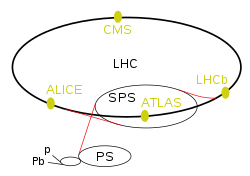
Back Groot Hadronversneller Afrikaans مصادم الهدرونات الكبير Arabic زداح لكبير د لهادرونات ARY বৃহৎ হেড্ৰ'ন সংঘৰ্ষক Assamese Gran colisionador d'hadrones AST Böyük adron sürətləndiricisi Azerbaijani Вялікі адронны калайдар Byelorussian Вялікі гадронны калайдэр BE-X-OLD Голям адронен ускорител Bulgarian বৃহৎ হ্যাড্রন সংঘর্ষক Bengali/Bangla
 Layout of the LHC complex | |
| General properties | |
|---|---|
| Accelerator type | Synchrotron |
| Beam type | proton, heavy ion |
| Target type | collider |
| Beam properties | |
| Maximum energy | 6.8 TeV per beam (13.6 TeV collision energy) |
| Maximum luminosity | 1×1034/(cm2⋅s) |
| Physical properties | |
| Circumference | 26,659 metres (16.565 miles) |
| Location | Near Geneva, Switzerland; across the border of France and Switzerland. |
| Coordinates | 46°14′06″N 06°02′42″E / 46.23500°N 6.04500°E |
| Institution | CERN |
| Dates of operation | 2010 – present |
| Preceded by | Large Electron–Positron Collider |
 Plan of the LHC experiments and the preaccelerators. | |
| LHC experiments | |
|---|---|
| ATLAS | A Toroidal LHC Apparatus |
| CMS | Compact Muon Solenoid |
| LHCb | LHC-beauty |
| ALICE | A Large Ion Collider Experiment |
| TOTEM | Total Cross Section, Elastic Scattering and Diffraction Dissociation |
| LHCf | LHC-forward |
| MoEDAL | Monopole and Exotics Detector At the LHC |
| FASER | ForwArd Search ExpeRiment |
| SND | Scattering and Neutrino Detector |
| LHC preaccelerators | |
| p and Pb | Linear accelerators for protons (Linac 4) and lead (Linac 3) |
| (not marked) | Proton Synchrotron Booster |
| PS | Proton Synchrotron |
| SPS | Super Proton Synchrotron |
 | |
| Current particle and nuclear facilities | |
|---|---|
| LHC | Accelerates protons and heavy ions |
| LEIR | Accelerates ions |
| SPS | Accelerates protons and ions |
| PSB | Accelerates protons |
| PS | Accelerates protons or ions |
| Linac 3 | Injects heavy ions into LEIR |
| Linac4 | Accelerates ions |
| AD | Decelerates antiprotons |
| ELENA | Decelerates antiprotons |
| ISOLDE | Produces radioactive ion beams |
| MEDICIS | Produces isotopes for medical purposes |
The Large Hadron Collider (LHC) is the world's largest and highest-energy particle accelerator.[1][2] It was built by the European Organization for Nuclear Research (CERN) between 1998 and 2008, in collaboration with over 10,000 scientists, and hundreds of universities and laboratories across more than 100 countries.[3] It lies in a tunnel 27 kilometres (17 mi) in circumference and as deep as 175 metres (574 ft) beneath the France–Switzerland border near Geneva.
The first collisions were achieved in 2010 at an energy of 3.5 tera-electronvolts (TeV) per beam, about four times the previous world record.[4][5] The discovery of the Higgs boson at the LHC was announced in 2012. Between 2013 and 2015, the LHC was shut down and upgraded; after those upgrades it reached 6.5 TeV per beam (13.0 TeV total collision energy).[6][7][8][9] At the end of 2018, it was shut down for maintenance and further upgrades, and reopened over three years later in April 2022.[10]
The collider has four crossing points where the accelerated particles collide. Nine detectors,[11] each designed to detect different phenomena, are positioned around the crossing points. The LHC primarily collides proton beams, but it can also accelerate beams of heavy ions, such as in lead–lead collisions and proton–lead collisions.[12]
The LHC's goal is to allow physicists to test the predictions of different theories of particle physics, including measuring the properties of the Higgs boson,[13] searching for the large family of new particles predicted by supersymmetric theories,[14] and studying other unresolved questions in particle physics.
- ^ "The Large Hadron Collider". CERN. 28 June 2023.
- ^ Joel Achenbach (March 2012). "The God Particle". National Geographic Magazine. Archived from the original on 25 February 2008. Retrieved 25 February 2008.
- ^ Highfield, Roger (16 September 2008). "Large Hadron Collider: Thirteen ways to change the world". The Daily Telegraph. London. Archived from the original on 24 September 2009. Retrieved 10 October 2008.
- ^ "CERN LHC sees high-energy success". BBC News. 30 March 2010. Retrieved 30 March 2010.
- ^ "LHC to run at 4 TeV per beam in 2012". Media and Press Relations (Press release). CERN. 13 February 2012.
- ^ Cite error: The named reference
BBCwas invoked but never defined (see the help page). - ^ O'Luanaigh, Cian. "Proton beams are back in the LHC". CERN. Retrieved 24 April 2015.
- ^ Rincon, Paul (3 June 2015). "Large Hadron Collider turns on 'data tap'". Retrieved 28 August 2015.
- ^ Webb, Jonathan (21 May 2015). "LHC smashes energy record with test collisions". Retrieved 28 August 2015.
- ^ "2022 Digital Media Kit: Higgs10, LHC Run 3 and restart". CERN. 7 October 2023. Retrieved 10 October 2023.
- ^ "Facts and figures about the LHC". CERN. Retrieved 17 April 2023.
- ^ "Time for lead collisions in the LHC". CERN. 7 October 2023. Retrieved 10 October 2023.
- ^ "Missing Higgs". CERN. 2008. Retrieved 10 October 2008.
- ^ "Towards a superforce". CERN. 2008. Retrieved 10 October 2008.